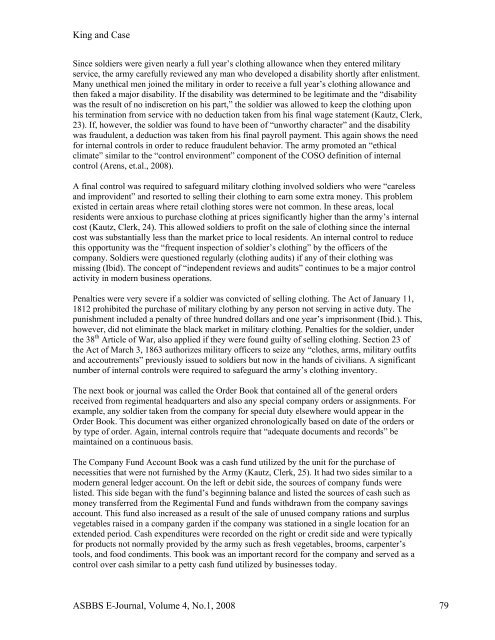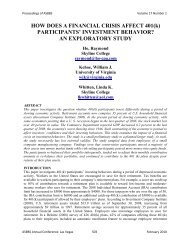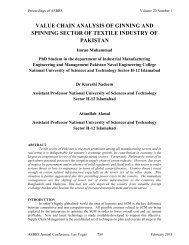stock repurchase announcements: a test of market ... - Asbbs.org
stock repurchase announcements: a test of market ... - Asbbs.org
stock repurchase announcements: a test of market ... - Asbbs.org
You also want an ePaper? Increase the reach of your titles
YUMPU automatically turns print PDFs into web optimized ePapers that Google loves.
King and Case<br />
Since soldiers were given nearly a full year’s clothing allowance when they entered military<br />
service, the army carefully reviewed any man who developed a disability shortly after enlistment.<br />
Many unethical men joined the military in order to receive a full year’s clothing allowance and<br />
then faked a major disability. If the disability was determined to be legitimate and the “disability<br />
was the result <strong>of</strong> no indiscretion on his part,” the soldier was allowed to keep the clothing upon<br />
his termination from service with no deduction taken from his final wage statement (Kautz, Clerk,<br />
23). If, however, the soldier was found to have been <strong>of</strong> “unworthy character” and the disability<br />
was fraudulent, a deduction was taken from his final payroll payment. This again shows the need<br />
for internal controls in order to reduce fraudulent behavior. The army promoted an “ethical<br />
climate” similar to the “control environment” component <strong>of</strong> the COSO definition <strong>of</strong> internal<br />
control (Arens, et.al., 2008).<br />
A final control was required to safeguard military clothing involved soldiers who were “careless<br />
and improvident” and resorted to selling their clothing to earn some extra money. This problem<br />
existed in certain areas where retail clothing stores were not common. In these areas, local<br />
residents were anxious to purchase clothing at prices significantly higher than the army’s internal<br />
cost (Kautz, Clerk, 24). This allowed soldiers to pr<strong>of</strong>it on the sale <strong>of</strong> clothing since the internal<br />
cost was substantially less than the <strong>market</strong> price to local residents. An internal control to reduce<br />
this opportunity was the “frequent inspection <strong>of</strong> soldier’s clothing” by the <strong>of</strong>ficers <strong>of</strong> the<br />
company. Soldiers were questioned regularly (clothing audits) if any <strong>of</strong> their clothing was<br />
missing (Ibid). The concept <strong>of</strong> “independent reviews and audits” continues to be a major control<br />
activity in modern business operations.<br />
Penalties were very severe if a soldier was convicted <strong>of</strong> selling clothing. The Act <strong>of</strong> January 11,<br />
1812 prohibited the purchase <strong>of</strong> military clothing by any person not serving in active duty. The<br />
punishment included a penalty <strong>of</strong> three hundred dollars and one year’s imprisonment (Ibid.). This,<br />
however, did not eliminate the black <strong>market</strong> in military clothing. Penalties for the soldier, under<br />
the 38 th Article <strong>of</strong> War, also applied if they were found guilty <strong>of</strong> selling clothing. Section 23 <strong>of</strong><br />
the Act <strong>of</strong> March 3, 1863 authorizes military <strong>of</strong>ficers to seize any “clothes, arms, military outfits<br />
and accoutrements” previously issued to soldiers but now in the hands <strong>of</strong> civilians. A significant<br />
number <strong>of</strong> internal controls were required to safeguard the army’s clothing inventory.<br />
The next book or journal was called the Order Book that contained all <strong>of</strong> the general orders<br />
received from regimental headquarters and also any special company orders or assignments. For<br />
example, any soldier taken from the company for special duty elsewhere would appear in the<br />
Order Book. This document was either <strong>org</strong>anized chronologically based on date <strong>of</strong> the orders or<br />
by type <strong>of</strong> order. Again, internal controls require that “adequate documents and records” be<br />
maintained on a continuous basis.<br />
The Company Fund Account Book was a cash fund utilized by the unit for the purchase <strong>of</strong><br />
necessities that were not furnished by the Army (Kautz, Clerk, 25). It had two sides similar to a<br />
modern general ledger account. On the left or debit side, the sources <strong>of</strong> company funds were<br />
listed. This side began with the fund’s beginning balance and listed the sources <strong>of</strong> cash such as<br />
money transferred from the Regimental Fund and funds withdrawn from the company savings<br />
account. This fund also increased as a result <strong>of</strong> the sale <strong>of</strong> unused company rations and surplus<br />
vegetables raised in a company garden if the company was stationed in a single location for an<br />
extended period. Cash expenditures were recorded on the right or credit side and were typically<br />
for products not normally provided by the army such as fresh vegetables, brooms, carpenter’s<br />
tools, and food condiments. This book was an important record for the company and served as a<br />
control over cash similar to a petty cash fund utilized by businesses today.<br />
ASBBS E-Journal, Volume 4, No.1, 2008 79

















